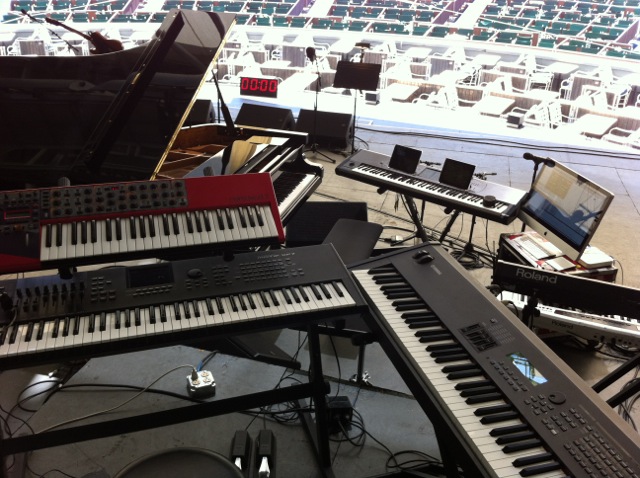
View from my chair at the Hollywood Bowl, August 2012: Herbie Hancock, Wayne Shorter, Carlos Santana, Marcus Miller, Zakir Hussein, the Concert for Peace
I am available for Skype Lessons, Clinics and Master Classes, and am now teaching Production Lessons on everything I do in Apple’s Logic software. A few thoughts on my approach to instruction:
Improvised music is to me the highest expression of the human potential. It’s a fusion of extreme mental acuity, great physical dexterity, a lot of determination and discipline and, more than anything else, a very liberal dose of what’s best about the human soul. You need to be in touch with every aspect of yourself in a way that’s unique to playing jazz. Mastery of improvised music requires a lot of development in a myriad of different ways, each of which needs to build upon the other as one learns. Much of what makes a great musician is intangible. But to a surprising degree, that mysterious force can be nurtured and developed as a solid framework of knowledge, technique and a lot of wisdom and perspective is built; to me the essence of teaching improvisation is helping a student build this framework. And it’s a very satisfying thing to watch them then find themselves as a musician as the dozens of facets in this structure come together.
After 25 years working with some of the world’s great musicians, I bring a lot of real-world experience and insight to the mission of helping aspiring musicians realize their full potential. From improvisational theory to piano technique, from harmony and composition to music production, I’ve distilled an approach to teaching that cuts through the mystery of making music and gives serious students the tools to get off and running. Much of what I teach is essentially a collection of “physics principles” of modern music that provide the student with a concrete way to get going, and to quickly understand what makes a great musician sound different than a struggling one. A large majority of great improvisors were either taught these ideas or understand them intuitively; as we study their work they are clearly illuminated. We don’t learn to ride a bicycle by just sitting on it; we need to be in motion to get a feel for the dynamic of riding it, and the same applies to music: giving a student a wide variety of tools for constructing melodies and harmonic ideas that sound musical because they follow these physics principles puts them in motion, and that’s a great beginning of the journey.
Feel free to visit the links on this website, through which you can learn more about who I am, what I’ve done in my career, and how I approach the quest to help musicians develop the skills necessary to master improvised music. I teach anywhere in the world via Skype and at my studio in the mountains above San Bernardino, and teach theory, production, composition, and improvisation on all instruments in addition to the study of piano. Finally, I am mid-way through the process of creating an extensive video instruction series on everything I do: playing in a wide variety of contexts, producing tracks (both live and on the sequencer), mixing and mastering, composing, arranging, and general music-industry guidance. This I expect to launch sometime in May of 2013.

